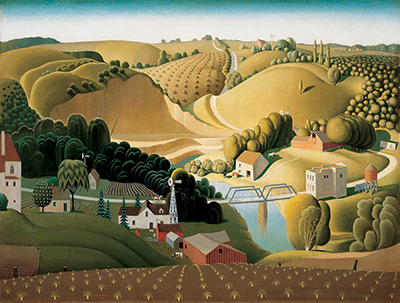Grant Wood is best known for American Gothic, but many of his paintings, such as this one Stone City, Iowa, are equally meritorious.
Wood's effortless style, realistic yet stylised, belies the difficulty of rendering in two dimensions the reality of three-dimensional life. This image seems like an illusion, stretching away into the distance and creating an illusion of timeless spaciousness that many a modern art student would sacrifice a great deal to be able to achieve. The clever illusion of depth is creating with the layers of landscape: the precisely planted crop in the extreme foreground, leading to the cluster of buildings and the bridge, following on to the quarried cliff, and on again to the various hills, fields and forested edges, each leading the eye deeper into rather than upwards on the canvas.
Wood's palette, as always, is simple and earthy. Muted greens and yellows mark the forests and grassy areas, rich reddish soil implies fertile soils and even the houses, buildings and bridges are muted and depicted in colours that would readily be found in nature. Despite these soft shades – edging towards pastel in some cases – the painting is bright and fresh, the contrasts showing up well thanks to Wood's simple impressionistic style which is characterised by sharp delineation, with none of the soft blurring so loved by older, more classic, Impressionists. The painting is dynamic, despite its bucolic tranquillity, with the sweeping curves of quarry, hills, pathway and landscape exploding from the quiet centre of the image, the placid vertical and horizon criss-cross of the bridge over the water.
The tranquillity, sadly, was based in reality. Stone Town had recently been a boomtown, now gone bust, but still, at the time of the painting, holding the apparent promise of prosperity. The town's decline was softened by Wood himself: he would run an artist's retreat in the town for two years following the completion of the painting. This painting was completed during the same year as the more famous American Gothic: 1930, and is in oil paint on wooden panels. This combination of oil on wood often adds a lustrous depth to colours and textures within paintings, and this holds true in this painting too. It is just over thirty inches tall and forty inches wide. The painting can be seen in the Joslyn Art Museum, in Omaha, where it is part of that establishment's large and impressive permanent collection.




